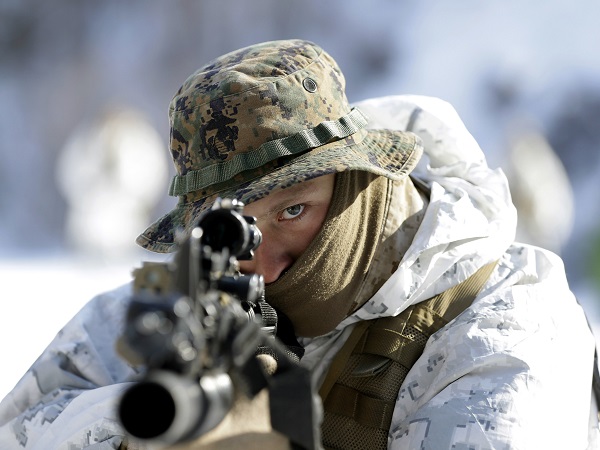SKorea ups alert ahead of North missile launch

In this Feb. 7, 2013 file photo, an unidentified U.S. Marine from 3-Marine Expeditionary Force 1st Battalion from Kaneho Bay, Hawaii, aims his gun during a joint military winter exercise with their South Korean counterparts in Pyeongchang, east of Seoul, South Korea. As tensions rise on the Korean Peninsula, one thing remains certain: All sides have good reason to avoid an all-out war. The last one, six decades ago, killed an estimated 4 million people. AP FILE PHOTO/Lee Jin-man
SEOUL — South Korea raised its military watch alert to “vital threat” Wednesday ahead of an expected North Korean missile launch, as UN chief Ban Ki-moon warned the Korean peninsula may be slipping out of control.
South Korean intelligence says the North had prepared two mid-range missiles for imminent launch from its east coast, despite warnings from ally China to avoid provocative moves at a time of soaring military tensions.
Last week, North Korea told foreign diplomats in Pyongyang they had until April 10 to consider evacuation, fuelling speculation that a launch was planned between Wednesday and the April 15 birthday celebrations for founding leader Kim Il-Sung.
On Tuesday, the North reiterated a warning that the Korean peninsula was headed for “thermo-nuclear” war and advised foreigners to consider leaving South Korea.
In a further sign of the rising nuclear tensions, a key border crossing between North Korea and China has been closed to tourist groups, a Chinese official said Wednesday.
Article continues after this advertisementThe South Korea-US Combined Forces Command raised its “Watchcon” status from 3 to 2 reflecting indications of a “vital threat”, Yonhap news agency said, citing a senior military official.
Article continues after this advertisementWatchcon 4 is in effect during normal peacetime, while Watchcon 3 reflects indications of an important threat. Watchcon 1 is used in wartime.
In a separate report, Yonhap quoted a government source as saying Pyongyang might be preparing “multiple” launches, after other launch vehicles were reportedly detected carrying shorter-range SCUD and Rodong missiles.
Although the North’s warnings to embassies in Pyongyang and foreigners in the South were both largely shrugged off, there is growing global concern that sky-high tensions might trigger an incident that could swiftly escalate.
UN Secretary General Ban Ki-moon said during a visit to Rome that he had spoken to the Chinese leadership to try to calm tensions, and would discuss the issue with US President Barack Obama on Thursday.
“The current level of tension is very dangerous, a small incident caused by miscalculation or misjudgement may create an uncontrollable situation,” Ban said.
White House spokesman Jay Carney, meanwhile, criticized Pyongyang for more “unhelpful rhetoric” that only served to create more uncertainty.
North Korea has wielded the “thermo-nuclear war” threat several times in recent months – most recently on March 7 – despite expert opinion that it is nowhere near developing such an advanced nuclear device.
The current crisis on the Korean peninsula has been intensifying almost daily since the North’s third nuclear test in February, which drew toughened UN sanctions.
Incensed by ongoing South Korean-US military exercises, Pyongyang has accused Washington and Seoul of preparing an invasion and threatened dire military actions from artillery barrages to nuclear strikes.
The mid-range missiles mobilised by the North are reported to be untested Musudan models with an estimated range of anywhere up to 4,000 kilometers (2,485 miles).
That would cover any target in South Korea and Japan, and possibly even US military bases on the Pacific island of Guam.
Japan, where the armed forces have been authorised to shoot down any North Korean missile headed towards its territory, said Tuesday it had deployed Patriot missiles in its capital as a pre-emptive defense measure.
A top US military commander said Tuesday that he favoured shooting down a North Korean missile only if it threatened the United States or Washington’s allies in the region.
On Tuesday, North Korea withdrew its 53,000 workers from the Kaesong joint industrial zone with South Korea, signalling the possible demise of the sole surviving symbol of cross-border reconciliation.
Established in 2004, Kaesong has never closed before. Pyongyang’s move reflects the depth of the current crisis, which has otherwise been notable more for fiery rhetoric than action.